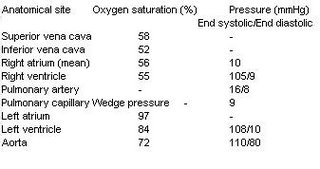Today I am going to talk about the last part of this important topic- Cardiac Catheterization in MRCP. In my previous two posts, we have learned about some common cases concerning cardiac catherization in MRCP. I am going to show two more cases here,
 Case 1:
Case 1:
Coarctation of the aorta

This is an easy case!There is a steep systolic gradient between the left ventricle and the femoral artery; the gradient is calculated as 190 – 150 = 40 mmHg. Therefore the diagnosis is Coarctation of the aorta.
Case 2:
Tetralogy of Fallot

You notice a combination of pressure and oxygen saturation abnormalities. The abnormalities are,
i) Step-down in oxygen saturation between LA and LV, indicating right to left shunt at the level of the ventricles, therefore there is presence of VSD.
ii) Pulmonary stenosis: there is an 89 mmHg gradient across the pulmonary valve (RV systolic – PA systolic).
iii) RVH: Right ventricular pressures are high and there is a right to left shunt, as indicated by the oxygen saturations
Hope you find this information useful. Remember, in MRCP examination, you may be given the result of a cardiac catheterization and asked about the correct physical signs of a patient. In other type of question setting, you maybe given some important physical signs and the examiners want you to find the correct cardiac catheterization results.

No comments:
Post a Comment